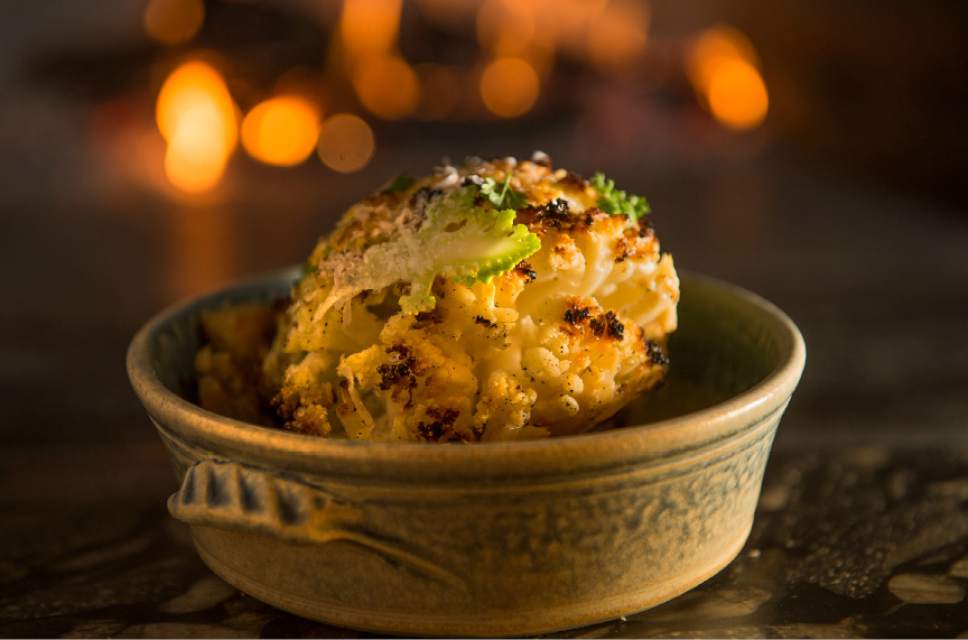This is an archived article that was published on sltrib.com in 2017, and information in the article may be outdated. It is provided only for personal research purposes and may not be reprinted.
Once upon a time, cauliflower was a bland, steamed side dish, eaten only when bathed in a gooey, orange cheese sauce.
But as tastes and diets have evolved, this cruciferous vegetable is now the cool kid on the dinner plate and, according to The James Beard Foundation, is well on its way to surpassing kale — the leafy green darling of the past few years — in popularity.
"Cauliflower is the new kale," the foundation declared last month when it released its 2017 Food Trend Forecast, a list of 13 foods to look for in the new year.
"It's hard to top the ubiquity of everyone's favorite leafy green, but the formerly overlooked cauliflower is right on its heels," the report notes. "Maybe it's the mild flavor that makes for a stellar blank canvas, or its comforting starchy consistency."
Excuse the alliteration, but restaurant chefs and home cooks are using this versatile, vitamin-rich vegetable in a variety of ways: chopped to resemble rice; mashed as a substitute for potatoes; mixed with tahini for hummus.
Why put raw florets on a vegetable tray when cauliflower can have a more dramatic presentation: roasted whole, sliced lengthwise into "steaks" or pressed thin for a grain-free pizza crust?
Creative types have taken this healthy vegetable — high in vitamin C and a good source of folate and fiber — to the extreme, making bread, tortillas, cupcakes and even ice cream with a cauliflower base.
No matter which way it's served, "we're devouring the cruciferous veg all over the country," the Beard Foundation concludes.
Briar Handly is blazing the cauliflower trail among Utah chefs. He serves General Tso's cauliflower, a take on the battered and fried Chinese dish, at HSL in Salt Lake City, and a spicy buffalo cauliflower, tossed in Frank's RedHot cayenne pepper sauce, at Handle in Park City.
"Something familiar with a little twist," said Handly of the two offerings, which have been so popular that the restaurants must order copious amounts of cauliflower — more than 100 heads a week—to keep up with demand.
He's expecting to do the same in 2017.
Handly's most recent variation is a whole head of cauliflower, roasted in a wood-fired oven and served with a rustic Romesco sauce made with house-smoked paprika. "It chars on the outside, but has this condensed flavor inside," he explained. "When you cut it, it's almost steaklike."
Handly enjoys experimenting with the mild-tasting vegetable since it can stand up to bold flavors. "It pairs with just about anything," he said.
In a meat-driven industry, Handly also has taken a more worldly view of the produce he buys.
"I really appreciate the vegetables that are grown for us and I try to respect them as much as I would a piece of Kobe beef," he said. "We're trying to break out of that mold and highlight vegetables in a different way, and cauliflower has been the leading vegetable in that trend."
From cookbooks and magazines to recipe blogs and social media sites, such as Pinterest, home cooks are experimenting with cauliflower as well.
"Cauliflower is having its little moment in the sun," said Utah's Kalyn Denny, author of the low-carb blog kalynskitchen.com.
While cauliflower has been readily available for a long time, "within the last year or two, it's been used in ways we've never seen before," she said, fueled in part by those following low-carb, paleo, vegan and vegetarian diets.
Denny said one of her most popular recipes of 2016 was her easy cauliflower rice, which uses garlic-infused oil and a generous amount of chopped green onions to flavor the vegetable. (See recipe below.)
"Even people who typically don't like cauliflower enjoy it," she said.
While a food processor will chop raw cauliflower easily, or purée cooked florets in seconds, food manufacturers are stepping in to make it even more convenient for cooks. Green Giant, Trader Joe's and Kroger are among the companies that have introduced bags of riced, mashed and crumbled cauliflower in the frozen-food sections at most grocery stores.
"When Green Giant has it, you know it's mainstream," said Denny, who predicted that cauliflower's popularity would last longer than that of kale because of its versatility.
"Kale is always going to taste like kale and there are some people who are never going to like it," she said. "But with cauliflower, most people can find a variation they like."
So is kale's reign as American superfood over?
No. The James Beard Foundation predicts that one of its offspring, kalettes, will soon break into the dining scene. This cross between kale and Brussels sprouts is "cute as can be" and delicious, they wrote.
"The first time we saw tiny little kale growing off of what looked like a Brussels sprout stalk at the greenmarket, we thought that some plant hybridist somewhere was also a marketing genius: What a great idea to take the two most unexpectedly and wildly trendy vegetables (and both brassicas, no less) and fuse them together."
kathys@sltrib.com
—
Easy cauliflower rice with garlic and green onions
4 heaping cups cauliflower pieces and stems
2 tablespoons olive oil
6 to 8 large cloves of garlic, peeled and cut in half lengthwise
1 cup sliced green onion
Salt
Fresh-ground black pepper to taste
Cut the cauliflower, including the stems, into small, same-size pieces until you have four generous cups. In a food processor, using the steel blade, process 2 cups of cauliflower at a time, buzzing in short bursts until finely chopped and until it is slightly larger than rice.
Heat oil in a non-stick frying pan over medium-high heat until it feels hot when you hold your hand over it. Add garlic cloves and stir-fry until aromatic. As soon as you see the tiniest color change in the garlic, immediately remove the garlic and discard. (Don't let it brown or the garlic will leave a bitter taste.)
Add cauliflower to the hot pan and season generously with salt and fresh-ground black pepper. Stir-fry the cauliflower, turning often, until it starts to soften and lose the raw taste, 3 to 4 minutes. Taste a little to see if it's done to your liking. (I prefer it still slightly crisp.) Turn off the heat, stir in the green onions, and serve immediately.
Servings • 4
Source: Kalyn Denny at KalynsKitchen.com
—
Cauliflower steaks with ginger-soy sauce
1 large head of cauliflower, very end of stem trimmed
1 tablespoon olive oil
2 teaspoons low-sodium soy sauce
2 teaspoons water
Pinch of sugar
1 green onion, finely minced
1 teaspoon finely grated ginger
2 teaspoons toasted sesame seeds
Heat oven to 400 degrees. Cut the cauliflower lengthwise, including the stalk, into 3/4-inch slices and place on a large baking sheet. It's OK if the slices overlap a bit. Drizzle with olive oil. Roast for 25 minutes, or until the tops are lightly browned in places and the stems are easily pierced with a fork.
Whisk together the remaining ingredients and pour over the cauliflower to serve.
Servings • 4
Source: Steamy Kitchen's Healthy Asian Favorites by Jaden Hair
—
Creamy mashed cauliflower
8 cups bite-size cauliflower florets (about 1 head)
4 cloves garlic, crushed and peeled
1/3 cup nonfat buttermilk (see tip)
4 teaspoons extra-virgin olive oil, divided
1 teaspoon butter
1/2 teaspoon salt
Freshly ground pepper to taste
Snipped fresh chives for garnish
Place cauliflower florets and garlic in a steamer basket over boiling water, cover and steam until tender, 12 to 15 minutes. (Alternatively, place florets and garlic in a microwave-safe bowl with ¼ cup water, cover and microwave on high for 3 to 5 minutes.) Place the cooked cauliflower and garlic in a food processor. Add buttermilk, 2 teaspoons oil, butter, salt and pepper; pulse several times, then process until smooth and creamy. Transfer to a serving bowl. Drizzle with the remaining 2 teaspoons oil and garnish with chives, if desired. Serve hot.
Tip: No buttermilk? You can use buttermilk powder prepared according to package directions. Or make "sour milk": mix 1 tablespoon lemon juice or vinegar to 1 cup milk.
Servings • 4
Source: Eating Well









